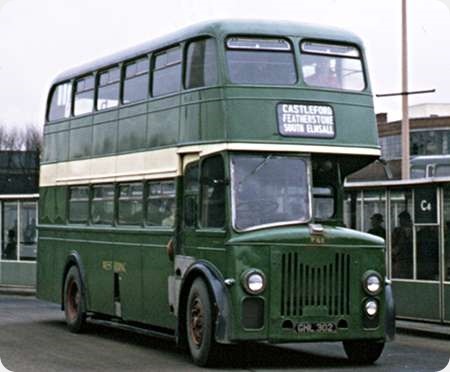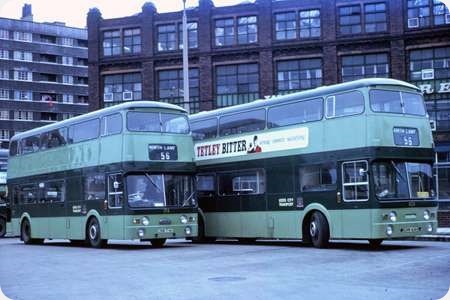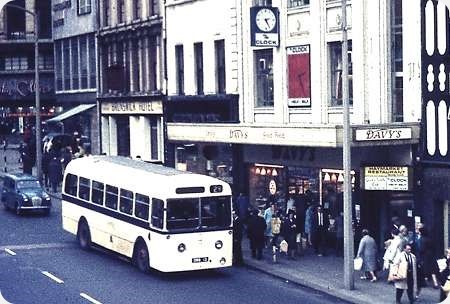West Riding – Leyland Titan PD2 – GHL 302 – 753
West Riding Automobile
1954
Leyland Titan PD2/22
Roe L24/26R
During the mid 1950s West Riding favoured the Leyland PD2 for its double deck requirements, taking 12 in 1953 with Roe L27/26R bodywork, and a further 10 in 1954, also with Roe lowbridge bodies, but in these the upper deck capacity was reduced to 24. The tin fronted PD2/22 was 7ft 6ins wide and had vacuum brakes. From 1955 West Riding turned to the Guy Arab with Roe bodywork and maintained its allegiance with Guy into the ill fated Wulfrunian saga. GHL 302 was delivered in November 1954 with fleet number 753, but that does not appear to be the number being carried when it was photographed in Leeds in April 1970, which looks something like 833 or 853, originally Guy Arab numbers, though the first digit is partially missing. Can anyone explain, please?
Photograph and Copy contributed by Roger Cox
20/01/22 – 06:48
A couple of points I’m unsure of:
1) Didn’t West Riding co-operate with Guy in the Wulfrunian project?
2) I seem to recall seeing pictures of West Riding buses in red, or was this my wild imaginings?
Chris Hebbron
21/01/22 – 06:15
West Riding had its origins in the Wakefield and District Light Railway Company formed in 1903 to build tramways centred on that town. Two years later this company was taken over by the Yorkshire (West Riding) Electric Tramways Company, itself a subsidiary of the Yorkshire Electric Tramways Construction Syndicate Ltd, which had ambitious plans, authorised in the West Riding Tramways Act of 1904, to construct an additional fifty miles of tramways. In practice most was not built and the initial Wakefield and District network formed the core of the tramway operations authorised by statute. In became apparent by the 1920s that the future of road public transport lay in the increasingly sophisticated motor bus rather than the tram, and the Yorkshire (West Riding) Electric Tramways Company formed a subsidiary, the West Riding Automobile Company to operate its bus fleet. The tram network was finally abandoned in 1932, to be taken over by buses, and accordingly the Yorkshire (West Riding) Electric Tramways Company was renamed the West Riding Automobile Company in 1935, with the subsidiary company of that name being wound up. All this forms the basis of the West Riding company’s colour schemes. The former statutory tramway services were operated by buses in the red livery, whilst the rest of the network, including the former Bullock operations purchased in 1950, ran buses in the green colour scheme. This continued up to the sale of the business to the Transport Holding Company in 1967 which then passed to the National Bus Company in 1969 and on into the aesthetically uninspiring era of Freddie Wood’s poppy red. The full history of the West Riding company’s tramway forebears may be found on the Local Transport History Library website.
Roger Cox
14/06/22 – 06:29
One of this batch of PD2/22s spent some time with Bannister T/A Isle Coaches of Owston Ferry, I believe they may have bought it via Dennis Higgs (Dealer). Can anybody tell me when it retired from West Riding and if it actually was bought by Dennis Higgs
Chris Proctor
17/06/22 – 06:10
(i) In answer to Roger’s query about the fleet number, I think the problem is simply that the camera does not take kindly to the flowery script. I have looked at a number of photos of this batch. In no case is there any mention in the text of any fleet number other than the original, and in no case can I read the fleet number on the bus unless I know what it’s supposed to be – and often not even then. This 1969 photo of GHL302 in the Transport Library (with typically wayward caption) shows it more clearly: https://thetransportlibrary.co.uk/
(ii) The same photo also shows an interesting feature of the bodywork. Normally Roe lowbridge bodies were built with equal depth windows all round on both decks. But here, and on the subsequent Guy Arabs, the lower-deck windows were deeper on the nearside than on the offside. This is quite a logical thing to do with the lowbridge layout, because of the intrusion of the sunken offside gangway into the lower saloon. But as far as I’m aware, Roe only did it for West Riding.
(iii) Chris asked about the Wulfrunian. The answer is that West Riding not only collaborated on the project, they inspired it. The Wulfrunian was developed at West Riding’s request.
Peter Williamson
Quick links to the - Comments Page - Contact Page - Home Page



